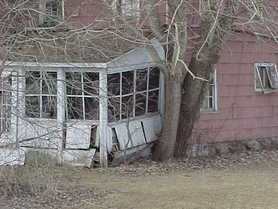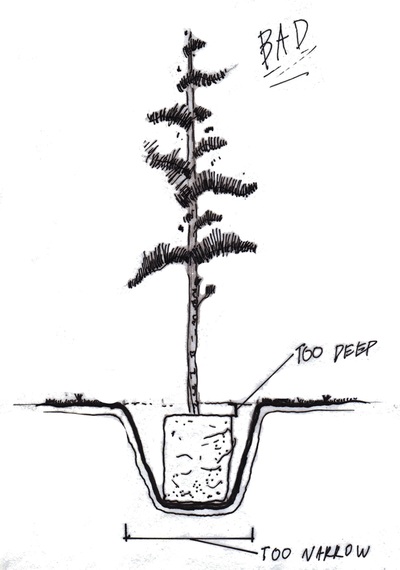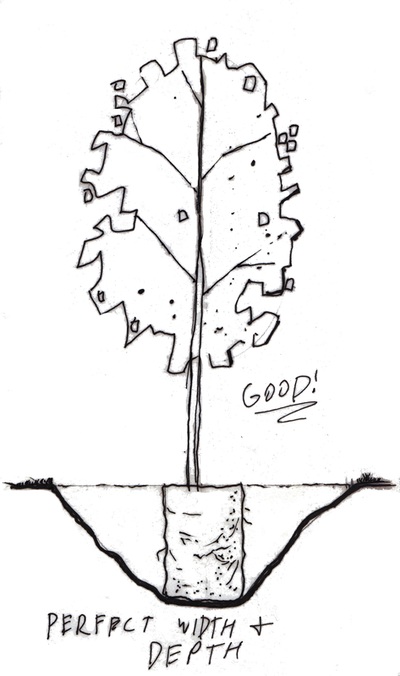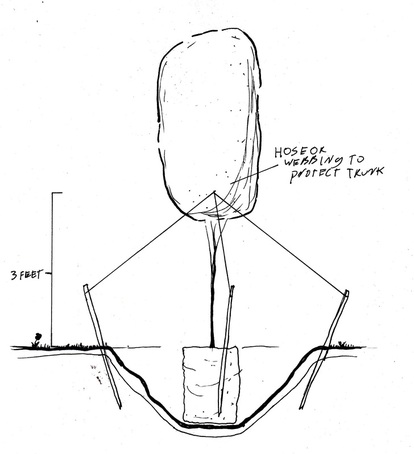|
So you bought tree, now what? Dig a hole, put tree in hole, fill up hole...right? Yeah, pretty much. However, there are some trees that are not properly suited to your soil and climatic conditions. That is what this article is about the planting of tree to ensure survival of an investment of both time and money.  Do I have your attention? Do I have your attention? First of all, lets assume the tree is near where you would like to plant it. Is this a good spot? Look at the tag and hopefully you asked some good questions at the nursery. You did ask good questions at the nursery, didn't you? The biggest consideration is sunlight tolerance. Is the site sunny, shady or somewhere in between? This something to ask your nurseryman, usually the tags are written in climates different than we have in Central Oklahoma and can be wrong, so ask. Second is tree size. Usually the tags are spot on here, but sometimes Oklahoma clay and wind can stunt growth. Are there structures in the way? If so, do you mind regular pruning? What about driveway or sidewalks that the trunk or roots could damage? Does the tree fruit? You may not want it near you car. Maybe fall litter will clog your gutters. Things to think about. The last major consideration is water. Is the area higher and dry or low and wet? Is it an area you can get water to easily? There are other things to think about but these are the major points. Now that you have thought about them it is time to go pick a tree, go ahead, I'll wait... Ok, good choice! Now there are a lot of sources that say amending the soil or even replacing the soil is the way to go. And sometimes it is. If you want to put a “dry” tree in a wet location. etc... But unless you dig a 20 X 20 X 20 hole, eventually the tree is going to be in your native soil. So here is what to do. The hole its self is actually the most important variable. It should be bowl shaped, wide and shallow. Depth is critical, you want to dig the hole the EXACT depth of the root ball. Too low it either stays wet and rots or the roots eventually girdle the tree. To high and it is hard to evenly water and it leaves an unsightly and unnatural bump in the soil with the roots showing. So the top of the root ball needs to be level with the top of the soil. The width of the “bowl” needs to be at least twice the width of the root ball. This ensures the roots will not hit a flat surface and be diverted into a circle. Our clay soil basically makes clay pots. Look up Frankoma Pottery sometime. Also don't leave smooth walls, rough them up with a shovel.
It's windy in Oklahoma. Tree are big kites. Young trees have puny root systems in loose soil. See a problem? Now what I see a lot of people doing is placing two T-posts on either side of the tree with wire or webbing supporting the tree high on the trunk and this works, that tree is not going to budge. However, weaker and faster growing trees, all trees really, react to their environment. If, while young they grow in an environment where they are not affected by wind they will not grow in such a way to brace themselves against the wind making them weak and brittle. If, however, they are allowed to be blown around a bit and only staked in such a way to keep the root ball in the ground, they will be strong and wind resistant. So you will need three three to four foot stakes hammered into the ground outside of the planting hole at a steep angle. From these stakes you want wire with section of hose or webbing to be placed about two or three feet up from the ground. After about a year, they should be good to remove. I usually recommend removing stakes the fall after the year is up. So if you planted a tree any time in 2016, you should remove the stakes in the fall of 2017. That's it! just water regularly. Using a cheap lawn sprinkler, water the so the spray reaches outward towards the outer branches. Do so for 20 to 30 minutes once a week or so. A sprinkler system will not work. Less ofter for a longer period.
1 Comment
|
Authors
Kathy and Alex have combined experience of over 25 years, and offer their expertise here. Archives
February 2019
Categories
All
|



 RSS Feed
RSS Feed